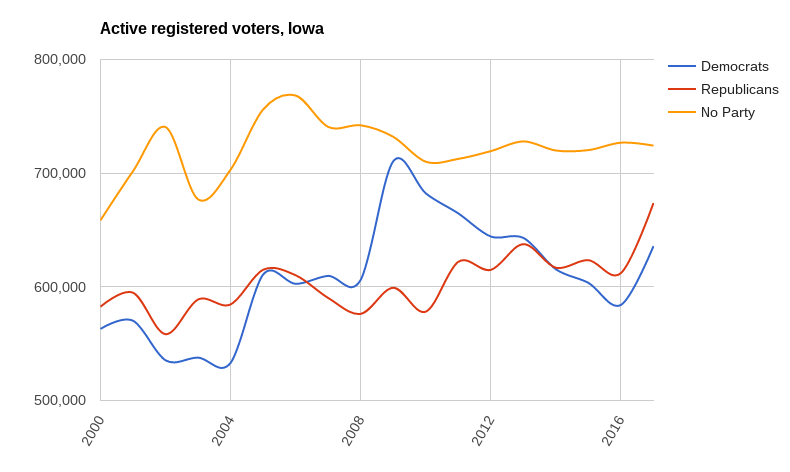For quite some time, Iowa was viewed as a swing state that usually leans Democratic. And its Democratic lean was never as evident as it was during the last two presidential elections, when Barack Obama was running for office.
That’s why Donald Trump’s blowout win there came as something of a shock. Yes, he had polled relatively well at times, but he was expected to squeak by, at best. In the end, he carried the state by a margin (9.4 points) larger than Hillary Clinton’s win in New Mexico (8.3 points), Virginia (5.4 points), or Colorado (4.9 points), and nearly as large as her win in Oregon (11 points).
Over at Decision Desk HQ (a must-read and must-follow site, by the way), Brandon Finnigan takes a look at partisan registration in the Hawkeye State, the numbers that might underlie a partisan shift. It definitely seems to be moving in a more Republican direction:
In January of 2013, there were 637,523 active registered Republicans, 643,103 registered Democrats, and 731,998 voters registered as independent or with other parties. At the start of last year, Republicans had taken a clear lead over the Democrats, 612,112 to 584,111, while independents remained the largest registered block at over 733,000. Democrats rebounded a bit over the course of 2016 but Republicans have continued to outpace them in registration with the latest release. As of yesterday, there are 673,712 active Republicans, 635,848 active Democrats, and 736,304 active voters registered as unaffiliated or with third parties.
The chart here shows the long-term trend, measured in January of each year from 2000 to 2017.

In 2000, when George W. Bush narrowly lost Iowa by a few thousand votes, Republicans had a slim advantage in voter registration. By the time voters voters went to caucus in 2008, Democrats outnumbered Republicans. In 2009, the Democrats’ advantage peaked at about 110,000 registrations, and the Democratic Party there has been in decline ever since.
Trump is surely part of the new GOP ascendancy — a sharp rise can be observed in 2016 — but Democratic registration fell behind before he became a candidate. And his win is only the second unexpectedly large Republican victory, after that of Sen. Joni Ernst, R, in 2014. If Iowa follows the path of Missouri, from swing-state to Republican powerhouse, it will change the way we view the electoral map in 2020. On the other hand, the Obama-era rise and fall of the Democratic Party in Iowa should serve as a reminder that nothing is permanent.

